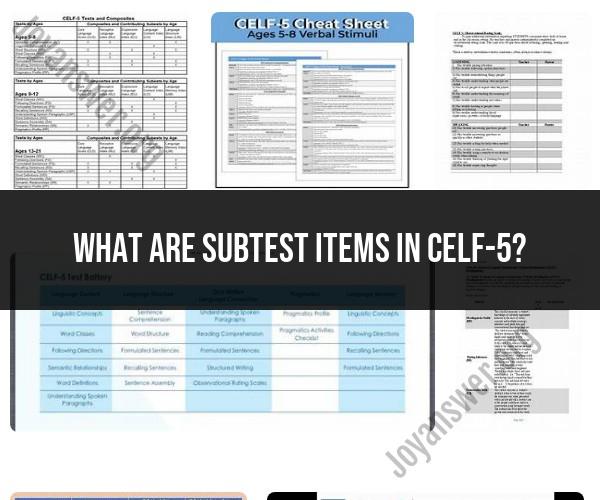What are subtest items in celf-5?
In the Clinical Evaluation of Language Fundamentals, Fifth Edition (CELF-5), subtest items refer to the specific tasks or questions that make up each subtest within the assessment. The CELF-5 is a standardized test used to assess various aspects of an individual's language skills, and it is divided into several subtests, each designed to evaluate different language abilities.
Here's a brief overview of subtest items in the CELF-5:
Subtests: The CELF-5 includes a variety of subtests, and the specific subtests administered may vary depending on the age and language abilities of the individual being assessed. These subtests cover different areas of language, including vocabulary, syntax, semantics, and more.
Items: Within each subtest, there are multiple individual items or tasks that the individual is asked to complete. These items can take various forms, including answering questions, completing sentences, providing definitions, and more. Each item is carefully designed to assess a specific aspect of language.
Scoring: The responses to these subtest items are scored according to standardized criteria. The scoring allows professionals, such as speech-language pathologists or psychologists, to evaluate the individual's language skills and compare their performance to standardized norms for their age group.
Subtest Example: As an example, one subtest in the CELF-5 might assess receptive vocabulary. In this subtest, the individual may be presented with a series of pictures or words and asked to point to or select the word that matches a given prompt. Each question or task within the subtest is considered a subtest item.
Composite Scores: The results of the individual subtests are often combined to calculate composite scores, which provide a more comprehensive assessment of the individual's language abilities. These composite scores can help in diagnosing language disorders, tracking progress, and making educational or intervention decisions.
It's important to note that the specific subtests and subtest items used in the CELF-5 assessment can vary depending on the age group and language abilities of the individual being assessed. The selection of subtests and items is based on the goals of the assessment and the need to evaluate various aspects of language development and functioning.
Exploring Subtest Items in CELF-5: What Are They?
The CELF-5 (Clinical Evaluation of Language Fundamentals-Fifth Edition) is a standardized test that is used to assess language skills in children and adolescents aged 5 to 18 years old. The CELF-5 includes subtests that measure a variety of language skills, including receptive language, expressive language, and oral language processing.
Subtest items are the specific questions or tasks that are presented to the test taker. Each subtest in the CELF-5 is made up of a variety of subtest items. The subtest items are designed to assess different aspects of language skills.
Understanding the Components: Subtest Items in the CELF-5 Assessment
The following are some of the different types of subtest items in the CELF-5 assessment:
- Following directions: The test taker is asked to follow a series of directions, such as "Point to the red ball." or "Put the blocks in the box."
- Word comprehension: The test taker is asked to define words or to identify the meaning of sentences.
- Sentence comprehension: The test taker is asked to listen to sentences and to answer questions about the sentences.
- Sentence assembly: The test taker is given a set of words and is asked to put the words in order to make a sentence.
- Word structure: The test taker is asked to identify the different parts of a word, such as the prefix, root, and suffix.
- Word classes: The test taker is asked to identify the different types of words, such as nouns, verbs, and adjectives.
- Formulated sentences: The test taker is asked to generate sentences in response to a prompt.
- Recalling sentences: The test taker is asked to listen to a sentence and then to repeat it back.
Analyzing Subtest Items for Comprehensive Language Evaluation
When analyzing CELF-5 subtest items, it is important to consider the following factors:
- The type of subtest item: The type of subtest item can provide information about the specific language skill that is being assessed.
- The difficulty of the subtest item: The difficulty of the subtest item can provide information about the test taker's level of language development.
- The test taker's response to the subtest item: The test taker's response to the subtest item can provide information about their strengths and weaknesses in language skills.
By analyzing CELF-5 subtest items, clinicians can gain a comprehensive understanding of a test taker's language skills. This information can be used to develop individualized education plans (IEPs) and intervention services.
Additional tips for analyzing CELF-5 subtest items
Here are some additional tips for analyzing CELF-5 subtest items:
- Consider the test taker's age and developmental level. The same subtest item may be more or less difficult for different test takers depending on their age and developmental level.
- Look for patterns in the test taker's performance. Are there certain types of subtest items that the test taker consistently performs well or poorly on? Identifying patterns in the test taker's performance can help to identify their strengths and weaknesses in language skills.
- Consider the test taker's cultural background. It is important to be aware of how the test taker's cultural background may influence their performance on the CELF-5. For example, a test taker from a non-English speaking background may perform more poorly on subtest items that require English vocabulary knowledge.
- Consult with other professionals. If you are unsure how to interpret the test taker's CELF-5 results, consult with other professionals, such as a speech-language pathologist or a psychologist.
By following these tips, you can effectively analyze CELF-5 subtest items to gain a comprehensive understanding of a test taker's language skills.













